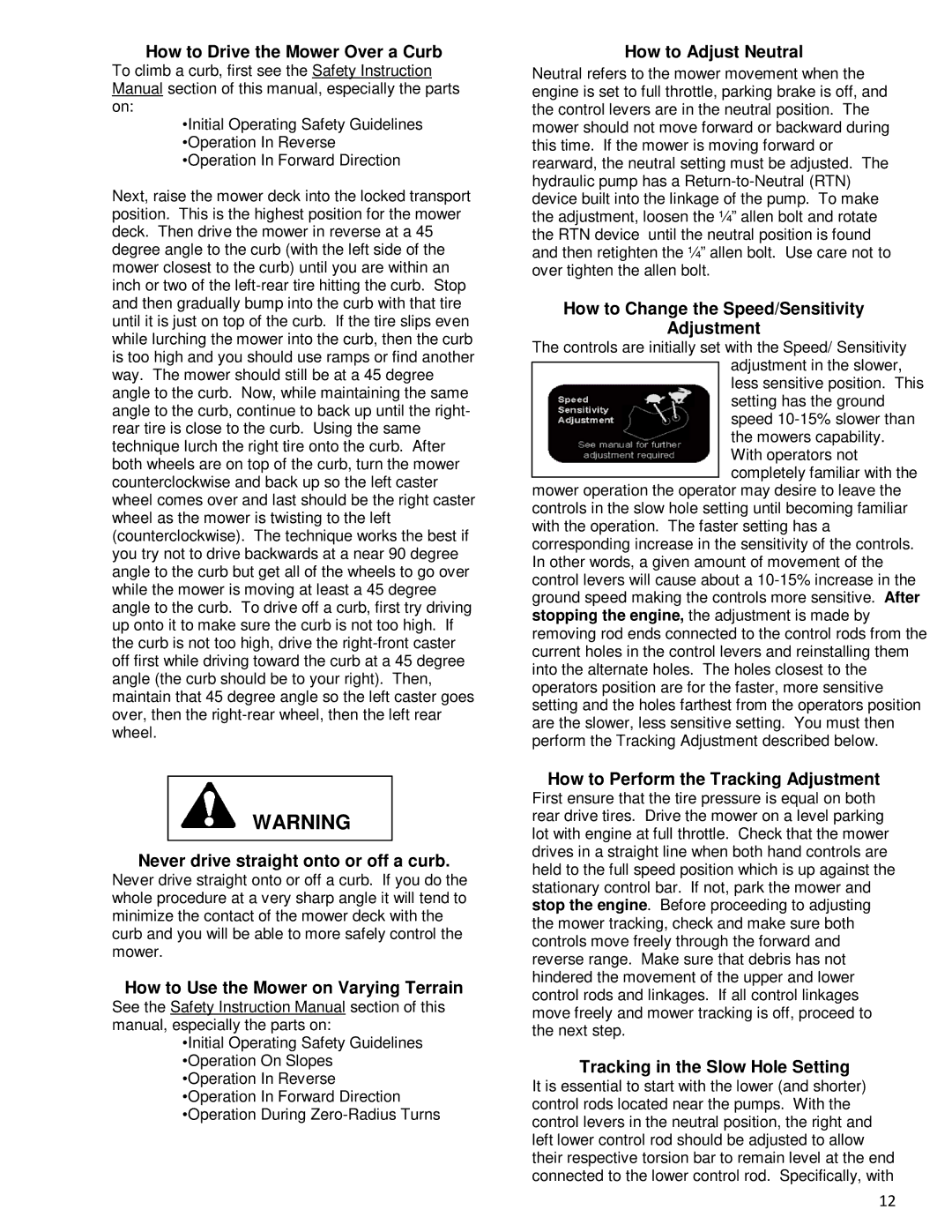How to Drive the Mower Over a Curb
To climb a curb, first see the Safety Instruction Manual section of this manual, especially the parts on:
•Initial Operating Safety Guidelines •Operation In Reverse •Operation In Forward Direction
Next, raise the mower deck into the locked transport position. This is the highest position for the mower deck. Then drive the mower in reverse at a 45 degree angle to the curb (with the left side of the mower closest to the curb) until you are within an inch or two of the left-rear tire hitting the curb. Stop and then gradually bump into the curb with that tire until it is just on top of the curb. If the tire slips even while lurching the mower into the curb, then the curb is too high and you should use ramps or find another way. The mower should still be at a 45 degree angle to the curb. Now, while maintaining the same angle to the curb, continue to back up until the right- rear tire is close to the curb. Using the same technique lurch the right tire onto the curb. After both wheels are on top of the curb, turn the mower counterclockwise and back up so the left caster wheel comes over and last should be the right caster wheel as the mower is twisting to the left (counterclockwise). The technique works the best if you try not to drive backwards at a near 90 degree angle to the curb but get all of the wheels to go over while the mower is moving at least a 45 degree angle to the curb. To drive off a curb, first try driving up onto it to make sure the curb is not too high. If the curb is not too high, drive the right-front caster off first while driving toward the curb at a 45 degree angle (the curb should be to your right). Then, maintain that 45 degree angle so the left caster goes over, then the right-rear wheel, then the left rear wheel.
WARNING
Never drive straight onto or off a curb.
Never drive straight onto or off a curb. If you do the whole procedure at a very sharp angle it will tend to minimize the contact of the mower deck with the curb and you will be able to more safely control the mower.
How to Use the Mower on Varying Terrain
See the Safety Instruction Manual section of this manual, especially the parts on:
•Initial Operating Safety Guidelines •Operation On Slopes •Operation In Reverse •Operation In Forward Direction •Operation During Zero-Radius Turns
How to Adjust Neutral
Neutral refers to the mower movement when the engine is set to full throttle, parking brake is off, and the control levers are in the neutral position. The mower should not move forward or backward during this time. If the mower is moving forward or rearward, the neutral setting must be adjusted. The hydraulic pump has a Return-to-Neutral (RTN) device built into the linkage of the pump. To make the adjustment, loosen the ¼” allen bolt and rotate the RTN device until the neutral position is found and then retighten the ¼” allen bolt. Use care not to over tighten the allen bolt.
How to Change the Speed/Sensitivity
Adjustment
The controls are initially set with the Speed/ Sensitivity adjustment in the slower, less sensitive position. This setting has the ground speed 10-15% slower than the mowers capability. With operators not completely familiar with the
mower operation the operator may desire to leave the controls in the slow hole setting until becoming familiar with the operation. The faster setting has a corresponding increase in the sensitivity of the controls. In other words, a given amount of movement of the control levers will cause about a 10-15% increase in the ground speed making the controls more sensitive. After stopping the engine, the adjustment is made by removing rod ends connected to the control rods from the current holes in the control levers and reinstalling them into the alternate holes. The holes closest to the operators position are for the faster, more sensitive setting and the holes farthest from the operators position are the slower, less sensitive setting. You must then perform the Tracking Adjustment described below.
How to Perform the Tracking Adjustment
First ensure that the tire pressure is equal on both rear drive tires. Drive the mower on a level parking lot with engine at full throttle. Check that the mower drives in a straight line when both hand controls are held to the full speed position which is up against the stationary control bar. If not, park the mower and stop the engine. Before proceeding to adjusting the mower tracking, check and make sure both controls move freely through the forward and reverse range. Make sure that debris has not hindered the movement of the upper and lower control rods and linkages. If all control linkages move freely and mower tracking is off, proceed to the next step.
Tracking in the Slow Hole Setting
It is essential to start with the lower (and shorter) control rods located near the pumps. With the control levers in the neutral position, the right and left lower control rod should be adjusted to allow their respective torsion bar to remain level at the end connected to the lower control rod. Specifically, with

